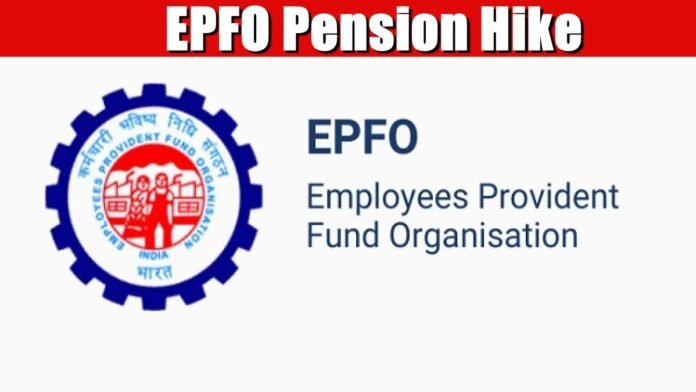
Key Points:
- Government considering increasing monthly EPFO pension from ₹1,000 to ₹2,500 under Employees’ Pension Scheme (EPS-95)
- Decision expected at Central Board of Trustees (CBT) meeting scheduled for October 10-11, 2025 in Bengaluru
- Current ₹1,000 minimum pension set in 2014; no revision in 11 years despite inflation
- Over 3 million pensioners currently receiving minimum pension of ₹1,000 per month
- Trade unions demanding ₹7,500 minimum pension, citing inadequacy against rising living costs
- EPS-95 scheme provides social security through 8.33% employee salary contribution plus 1.16% government contribution
- Eligibility requires minimum age 58 years and at least 10 years of service
- EPS-95 Fund currently facing actuarial deficit with insufficient funds for pension obligations
New Delhi: Private sector employees across India may soon receive welcome relief as the government contemplates a substantial increase in monthly pension payments under the Employees’ Pension Scheme (EPS-95). The proposal to raise the minimum monthly pension from ₹1,000 to ₹2,500 a 150 percent increase will be deliberated at the upcoming Central Board of Trustees (CBT) meeting of the Employees’ Provident Fund Organisation (EPFO) scheduled for October 10-11, 2025, in Bengaluru.
First Pension Revision in Over a Decade
If approved, this pension enhancement will mark the first revision in minimum pension rates in 11 years, providing much-needed financial support to millions of retired private sector workers struggling with inadequate monthly income. The current minimum pension of ₹1,000 per month was established in 2014 under the previous government and has remained unchanged despite significant inflation and rising cost of living over the past decade.
According to official estimates, more than 3 million pensioners are currently receiving this minimum pension amount, representing a substantial portion of EPS-95 beneficiaries who contributed to the scheme throughout their working careers. For these retirees, the proposed increase to ₹2,500 monthly would provide critical additional income to meet basic living expenses, medical costs, and other essential needs.
Understanding EPS-95 Framework
The Employees’ Pension Scheme 1995 (EPS-95) serves as a crucial social security mechanism designed to provide regular pension income to employees after retirement. The scheme operates through a defined contribution structure where 8.33 percent of an employee’s basic salary and dearness allowance is deposited into the EPS fund monthly by employers. This contribution is carved out from the overall 12 percent employer contribution to EPFO, with the remaining 3.67 percent going to the Employees’ Provident Fund (EPF).
In addition to employer contributions, the central government supplements the scheme by contributing an additional 1.16 percent of each employee’s salary to the pension fund. This government contribution demonstrates the scheme’s social security nature and the state’s commitment to ensuring dignified retirement for private sector workers.
A distinctive feature of EPS-95 is the government guarantee of a minimum monthly pension of ₹1,000, regardless of the fund’s financial position or individual contribution amounts. This floor ensures that even those with lower contributions or shorter service periods receive basic pension support, though the amount has increasingly become inadequate given contemporary living costs.
Long-Standing Demand for Pension Enhancement
Trade unions, pensioners’ associations, and workers’ organizations have consistently demanded substantial increases in minimum pension amounts for years. These groups have specifically advocated for a minimum monthly pension of ₹7,500, arguing that the current ₹1,000 is woefully insufficient in an era of high inflation and escalating healthcare costs.
Pensioners and their representatives contend that receiving merely ₹1,000 monthly after decades of service and regular contributions represents both economic hardship and an affront to their dignity. Many retirees struggle to afford basic necessities including food, medicine, housing expenses, and transportation on such meager income, particularly in urban areas where living costs have increased dramatically.
The proposed increase to ₹2,500, while welcomed, still falls far short of the ₹7,500 demand from unions. However, it would represent meaningful progress and could pave the way for further enhancements as the fund’s financial position improves and political will strengthens.
Inflation Impact on Pension Adequacy
To understand the urgency of pension revision, consider that ₹1,000 in 2014 possessed significantly greater purchasing power than the same amount today. Over the past 11 years, cumulative inflation has eroded the real value of pension income by approximately 50-60 percent, meaning pensioners can afford roughly half of what they could purchase when the rate was initially set.
Essential expenses including food grains, vegetables, cooking fuel, electricity, medical services, and prescription medicines have increased substantially. Healthcare costs, particularly critical for elderly populations, have risen even more sharply, with hospital charges, diagnostic tests, and medication prices increasing at rates exceeding general inflation.
For pensioners dependent solely on the ₹1,000 monthly payment without family support or other income sources, maintaining even a basic standard of living has become increasingly difficult. Many are forced to depend on children or other relatives for financial support, undermining the pension scheme’s fundamental purpose of providing financial independence during retirement.
EPS-95 Financial Challenges
The EPS-95 fund currently faces a significant actuarial deficit, meaning projected future pension liabilities exceed available assets and anticipated contributions. This financial strain results from several factors including increasing life expectancy (requiring longer pension payments), inadequate contribution rates relative to liabilities, and investment returns failing to keep pace with pension obligations.
The actuarial deficit poses challenges for implementing pension increases, as enhancing monthly payments would further widen the gap between income and expenditure. However, the government’s guarantee obligation means it must ultimately cover shortfalls to maintain minimum pension payments regardless of the fund’s financial position.
Addressing the actuarial deficit requires comprehensive solutions including potentially higher contribution rates, improved investment strategies, periodic government infusions, or structural reforms to align contributions with liabilities. The CBT meeting deliberations will need to balance pensioner welfare with long-term fund sustainability.
Eligibility Criteria and Coverage
The EPS-95 scheme establishes two primary eligibility conditions for receiving pension benefits. First, beneficiaries must be at least 58 years of age, representing the standard retirement age for pension commencement under the scheme. However, employees can opt for early pension from age 50 with reduced amounts, or defer pension beyond 58 for enhanced payments.
Second, employees must have completed a minimum of 10 years of eligible service contributing to EPS-95. This service requirement can be cumulative across multiple employers, provided all were covered under EPFO. The 10-year threshold ensures that only those with substantial employment histories receive pension benefits, distinguishing it from provident fund withdrawals available with shorter service.
The pension amount calculation for those contributing above minimum levels uses a formula considering years of service, average salary during the last 60 months of employment, and prescribed factors. However, regardless of calculated amounts, the scheme guarantees the minimum pension floor currently set at ₹1,000 monthly.
CBT Meeting Significance
The Central Board of Trustees serves as EPFO’s apex decision-making body, comprising representatives from central and state governments, employers, and employees (trade unions). The CBT meets periodically to deliberate policy matters, interest rates, pension enhancements, and administrative issues affecting millions of EPFO subscribers and pensioners.
The October 10-11 meeting in Bengaluru holds particular significance as pension revision features prominently on the agenda after years of demands and deliberations. The diverse composition of CBT means the proposal will undergo thorough examination from multiple stakeholder perspectives before any decision.
If the pension increase receives CBT approval, it would still require government notification and potentially parliamentary budgetary approval for the increased government contribution component. Implementation could follow within months of final approval, bringing immediate relief to millions of pensioners.
Broader Social Security Context
The proposed pension enhancement occurs within the broader context of India’s evolving social security architecture for workers. While government employees enjoy defined benefit pensions through the National Pension System or older schemes, private sector workers depend heavily on EPFO’s dual structure of provident fund accumulation and pension benefits.
Recent years have witnessed increased attention to retirement security as India’s population ages and traditional joint family support systems weaken. Ensuring adequate pension coverage and amounts represents not just an economic necessity but a social imperative to honor the contributions of workers who built the nation’s economy.
International comparisons reveal that India’s social security spending as a percentage of GDP remains relatively low compared to developed economies and even some developing nations. Enhancing pension amounts represents incremental progress toward more robust social protection systems that provide genuine security and dignity to retired workers.
Political and Economic Considerations
The timing of this proposal ahead of the CBT meeting may reflect political considerations alongside economic rationale. Pension increases generate goodwill among millions of beneficiaries and their families, potentially influencing electoral calculations and demonstrating government responsiveness to vulnerable populations.
However, fiscal implications cannot be ignored. Increasing minimum pension to ₹2,500 would significantly raise government expenditure through both higher guarantee payments and increased contribution obligations. With over 3 million minimum pension recipients, annual additional expenditure could exceed several thousand crores, requiring budgetary accommodation.
Balancing pensioner welfare with fiscal prudence, fund sustainability, and competing expenditure priorities presents complex policy challenges. The CBT deliberations will need to weigh these considerations carefully while recognizing the genuine hardship faced by elderly pensioners surviving on inadequate income.
Implementation Timeline and Process
If the CBT approves the pension increase during the October 10-11 meeting, several procedural steps would follow before actual implementation. The proposal would require formal government notification, potentially necessitating Finance Ministry clearance and Cabinet approval given budgetary implications.
Parliamentary procedures might be required if the increase demands supplementary budgetary allocations beyond existing provisions. The government would need to clarify effective dates, payment mechanisms, and whether arrears would be paid for any gap period between decision and implementation.
EPFO’s administrative machinery would need preparation to process enhanced payments for millions of beneficiaries, updating databases, modifying payment systems, and ensuring smooth transition without disruptions to monthly pension credits. Clear communication to pensioners about timelines and procedures would be essential to manage expectations and prevent confusion.
Looking Ahead
The proposed pension increase, if approved, would provide meaningful relief to millions of retired private sector workers while highlighting ongoing challenges in India’s social security landscape. It would represent recognition that pension adequacy must evolve with economic realities rather than remaining frozen for years despite inflation.
However, the gap between the proposed ₹2,500 and the demanded ₹7,500 suggests that further enhancements will remain on the agenda. Trade unions and pensioners’ associations will likely continue advocacy for higher minimum pensions, periodic inflation indexation, and structural improvements to ensure EPS-95 provides genuine retirement security.
The coming days leading to the CBT meeting will witness intense deliberations, stakeholder consultations, and possibly public statements from various interests. All eyes will be on Bengaluru on October 10-11 as trustees deliberate a decision affecting millions of Indian families dependent on pension income for basic survival and dignity in their sunset years.








































